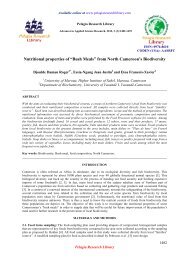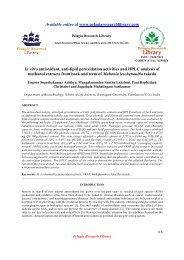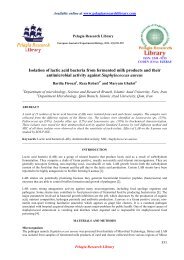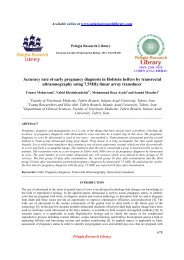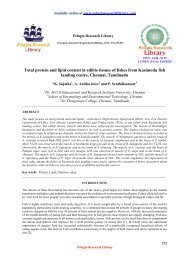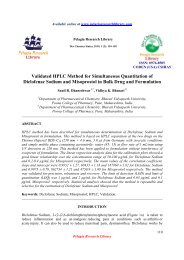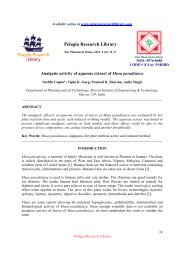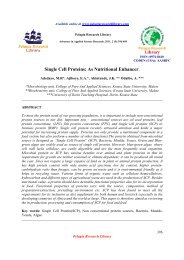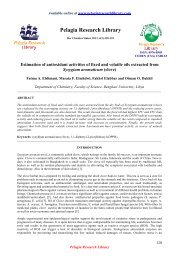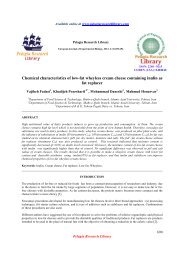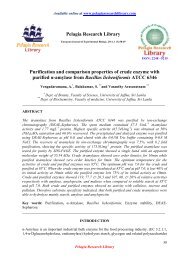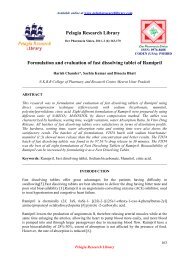Extraction and analysis of essential oil of Nirgundi - Pelagia ...
Extraction and analysis of essential oil of Nirgundi - Pelagia ...
Extraction and analysis of essential oil of Nirgundi - Pelagia ...
Create successful ePaper yourself
Turn your PDF publications into a flip-book with our unique Google optimized e-Paper software.
Available online at www.pelagiaresearchlibrary.com<br />
<strong>Pelagia</strong> Research Library<br />
Der Pharmacia Sinica, 2011, 2 (4): 262-266<br />
ISSN: 0976-8688<br />
CODEN (USA): PSHIBD<br />
<strong>Extraction</strong> <strong>and</strong> <strong>analysis</strong> <strong>of</strong> <strong>essential</strong> <strong>oil</strong> <strong>of</strong> <strong>Nirgundi</strong> (Vitex negundo L.)<br />
Anisha Singh*, Pramod K Sharma, Vipin K Garg, Sharad Visht<br />
Department <strong>of</strong> Pharmaceutical Technology, Meerut Institute <strong>of</strong> Engineering <strong>and</strong> Technology,<br />
Meerut, India<br />
_____________________________________________________________________________<br />
ABSTRACT<br />
All parts <strong>of</strong> the plant Vitex negundo L are known to have wide array <strong>of</strong> therapeutic activities <strong>and</strong><br />
their <strong>essential</strong> <strong>oil</strong> is no exception. The present study was carried out to assess the chemical<br />
composition <strong>of</strong> the <strong>essential</strong> <strong>oil</strong> <strong>of</strong> the plant. The <strong>essential</strong> <strong>oil</strong> was obtained by hydro-distillation<br />
<strong>of</strong> fresh leaves <strong>of</strong> the plant in Clevenger type apparatus for approximately 8 hrs (Yield being<br />
0.1%v/w). The extracted <strong>oil</strong> was analyzed using GC <strong>and</strong> GC/MS <strong>analysis</strong>. A total <strong>of</strong> 48<br />
compounds were detected, <strong>of</strong> which 19 compounds represented 88.65% <strong>of</strong> the <strong>oil</strong>. The<br />
Epiglobulol was found as a major component having 30.31% concentration. Some other<br />
compounds detected in considerable range were delta-iraleine (10.34%), terpinen-4-ol (9.42%),<br />
gamma-elemene (5.72%), manool (5.16%), beta-iso-methyl ion (4.46%), beyerene (3.79%), <strong>and</strong><br />
phytol (2.33%).<br />
Key Words: Vitex negundo L., Essential <strong>oil</strong>, GC, GC/MS.<br />
_____________________________________________________________________________<br />
INTRODUCTION<br />
For the past many years, medicinal plants <strong>and</strong> their modified derivatives have received the<br />
attention <strong>of</strong> scientific communities for their therapeutic <strong>and</strong> medicinal value. Essential <strong>oil</strong> <strong>of</strong><br />
plants shows many biological activities in addition to their use in food, flavor, perfumery,<br />
cosmetic <strong>and</strong> pharmaceutical industries. The secondary metabolites grouped as alkaloids,<br />
<strong>essential</strong> <strong>oil</strong>, glycosides etc. impart the much needed curative properties to them [1, 2]. As per<br />
World Health Organisation, about 80% <strong>of</strong> the day to day health care needs are met traditionally<br />
through medicinal <strong>and</strong> aromatic plants [3].<br />
Vitex negundo (verbenaceae) has been found usually at an altitude <strong>of</strong> 1500 meters in the tropical<br />
<strong>and</strong> temperate regions <strong>of</strong> Afganistan, Pakistan, Sri Lanka, Eastern Africa, Thail<strong>and</strong>, Madagaskar,<br />
Malaysia, South West China, Indonesia, <strong>and</strong> Philippines etc. [4 – 6].<br />
<strong>Pelagia</strong> Research Library<br />
262
Anisha Singh et al Der Pharmacia Sinica, 2011, 2(4):262-266<br />
______________________________________________________________________________<br />
Vitex comprises <strong>of</strong> about 250 species having tri or pentafoliate leaves borne on quadrangular<br />
branches. It bears bluish- purple coloured flowers in pendent branched tormentose cymes [6, 7].<br />
The plant shows anti-inflammatory, antifungal, antibacterial <strong>and</strong> analgesic activities. It is also<br />
used in traumatic epilepsy, polymenorrhoea, erratic menstrual cycles, eating disorders,<br />
amenorrhea <strong>and</strong> drug abuse etc. It finds its application in the treatment <strong>of</strong> superficial bruises,<br />
injuries, sores <strong>and</strong> skin infections as traditional medicines. Oil obtained from leaves increases<br />
hair growth <strong>and</strong> brain function. Roots play vital role in rheumatism, dyspepsia, piles etc. [8, 9].<br />
Although all plant parts are used, but the leaves <strong>and</strong> root extract constitute more significant<br />
medicinal activity [10].<br />
In this study, the <strong>essential</strong> <strong>oil</strong> <strong>of</strong> Vitex negundo was obtained by hydro-distillation <strong>and</strong> analyzed<br />
by GC <strong>and</strong> GC-MS technique.<br />
MATERIALS AND METHODS<br />
Plant material<br />
Fresh leaves <strong>of</strong> Vitex negundo (L.) were collected from Ganeshpur village at Dehradun–<br />
Saharanpur road in April 2011. The plant was authenticated by Dr. Anjula P<strong>and</strong>ey, Principal<br />
Scientist at National Bureau <strong>of</strong> Plant Genetic Resources, Pusa Campus, NewDelhi bearing<br />
voucher specimen no. NHPC/NBPGR/2011-2<br />
Essential <strong>oil</strong> extraction<br />
Fresh leaves <strong>of</strong> the plant (200g) were subjected to hydro-distillation for 8 hrs using closed type<br />
Clevenger apparatus. The pale yellow colored <strong>oil</strong> was collected over water, stored in culture tube<br />
<strong>and</strong> kept in refrigeration for storage. The yield <strong>of</strong> the volatile <strong>oil</strong> obtained was 0.1% v/w [11].<br />
GC <strong>and</strong> GC – MS <strong>analysis</strong><br />
GC Analysis:<br />
The <strong>essential</strong> <strong>oil</strong> was analyzed using a Shimadzu GC-2010 Gas chromatography equipped with<br />
flame ionization detector using AB-Innowax column (60 m x 0.25 mm ID, film thickness 0.25<br />
µm). Nitrogen was used as carrier gas at 162.1 kpa inlet pressure with 3.0 mL/min purge flow.<br />
Temperature programming was from 80 º C to 230 º C. Column oven temperature was held<br />
isothermal at 80 º C for 2 minutes then heated at 5 º C/min to 200 º C <strong>and</strong> held isothermal for 8<br />
minutes. Again it was heated at 7 º C/min to 230 º C <strong>and</strong> held isothermal for 15 minutes. The total<br />
program time <strong>of</strong> the instrument was 53.28 min. The injector <strong>and</strong> detector temperatures were<br />
270 º C <strong>and</strong> 280 º C respectively. The injector volume <strong>of</strong> the sample was 0.2µl. The <strong>oil</strong> was injected<br />
neat with split injection mode having split ratio <strong>of</strong> 1:80. The flow control mode adopted was<br />
linear velocity <strong>of</strong> 28.7 cm/sec. The column flow was 1.21 mL/min with total flow being 101.00<br />
mL/min. Quantitative results are mean data derived from GC <strong>analysis</strong>.<br />
GC/MS Analysis:<br />
GC/MS data was obtained on the Gas Chromatography-Mass Spectrometry (GC-MS)-2010 Plus<br />
Shimadzu making use <strong>of</strong> the same column. The ion source temperature was kept at 250 º C with<br />
interface temperature at 280 º C. The carrier gas used was helium. The temperature programming<br />
was same as in case <strong>of</strong> GC. Quantitative results are mean data derived from GC <strong>analysis</strong>. The<br />
mass range was 40 to 850 Dalton. The final confirmation <strong>of</strong> constituents was made by computer<br />
<strong>Pelagia</strong> Research Library<br />
263
Anisha Singh et al Der Pharmacia Sinica, 2011, 2(4):262-266<br />
______________________________________________________________________________<br />
matching <strong>of</strong> the mass spectra <strong>of</strong> peaks with the Wiley <strong>and</strong> Nist libraries mass spectral databases.<br />
Relative amounts <strong>of</strong> individual components are based on GC peak areas [12, 13].<br />
RESULTS AND DISCUSSION<br />
Fig. 1 Graph <strong>of</strong> GC <strong>analysis</strong><br />
The yield <strong>of</strong> <strong>essential</strong> <strong>oil</strong> from fresh leaves <strong>of</strong> Vitex negundo by hydro-distillation method using<br />
Clevenger type apparatus was found to be 0.1% v/w. The GC <strong>and</strong> GC/MS <strong>analysis</strong> showed the<br />
presence <strong>of</strong> 48 compounds, <strong>of</strong> which 19 major <strong>and</strong> some minor compounds constitute 88.71% <strong>of</strong><br />
the <strong>oil</strong> <strong>and</strong> 11.28% were found in trace amounts. Thus all the 48 compounds made up 99.99% <strong>of</strong><br />
the total <strong>essential</strong> <strong>oil</strong>. The major component was found to be Epiglobulol with 30.31% contrary<br />
to Lu ChangBing who found caryophyllene (35.97%) <strong>and</strong> eucalyptol (8.21%) [14], delta-iraleine<br />
(10.34%), terpinen-4-ol (9.42%), gamma-elemene (5.72%), manool (5.16%), beta-iso-methyl ion<br />
(4.46%), beyerene (3.79%), phytol (2.33%).<br />
The retention times <strong>and</strong> chemical composition <strong>of</strong> <strong>essential</strong> <strong>oil</strong>s <strong>of</strong> Vitex negundo are presented in<br />
Fig. 1 <strong>and</strong> Table 1.<br />
<strong>Pelagia</strong> Research Library<br />
264
Anisha Singh et al Der Pharmacia Sinica, 2011, 2(4):262-266<br />
______________________________________________________________________________<br />
Table 1 Retention time (RT) <strong>of</strong> different constituents’ <strong>essential</strong> <strong>oil</strong> <strong>of</strong> <strong>Nirgundi</strong><br />
Peak RT Area Area % Name<br />
1 5.086 676241 1.3806 Alpha-Pinene<br />
2 5.725 109682 0.2239 Sabinene<br />
3 6.726 214571 0.4381 Beta-Myrcene<br />
4 7.167 55534 0.1134 Alpha-terpinene<br />
5 7.827 143324 0.2926 Limonene<br />
6 8.027 68399 0.1396 Sabinene<br />
7 8.583 86292 0.1762 Gamma-Terpinene<br />
8 9.285 31444 0.0642 Alpha-Terpinolene<br />
9 9.474 63597 0.1298 Amyl isovalerate<br />
10 12.786 368149 0.7516 Amyl vinyl carbinol<br />
11 15.076 392226 0.8008 Linalool<br />
12 16.176 159592 0.3258 Beta-Elemene<br />
13 16.450 4616115 9.4244 Terpinen-4-ol<br />
14 16.575 980121 2.0010 Beta-Caryophyllene<br />
15 17.488 603134 1.2314 Allo-aromadendrene<br />
16 17.727 376682 0.7690 (Z) beta-Farnesene<br />
17 18.068 162933 0.3326 Alpha-Humulene<br />
18 18.579 224949 0.4593 p-menth-1-en-8-ol<br />
19 18.731 125197 0.2556 Viridiflorene<br />
20 19.195 126678 0.2586 Alpha-Selinene<br />
21 19.271 142461 0.2909 Alpha-selinene<br />
22 19.909 122750 0.2506 Delta-Cadinene<br />
23 21.567 73444 0.1499 Damascenone<br />
24 24.878 136186 0.2780 Luciferin aldehyde<br />
25 25.121 163042 0.3329 Caryophyllene oxide<br />
26 25.966 775350 1.5830 Ledol<br />
27 26.416 120308 0.2456 Hedycaryol<br />
28 26.951 861087 1.7580 Elemone<br />
29 27.172 14846843 30.3118 Epiglobulol<br />
30 27.321 5067130 10.3452 Delta-iraleine<br />
31 28.634 2804142 5.7250 Gamma-Elemene<br />
32 28.836 689551 1.4078 Iso-longifolol<br />
33 30.178 604523 1.2342 Alpha-Eudesmol<br />
34 30.404 226744 0.4629 Beta-Eudesmol<br />
35 30.801 913282 1.8646 Widdrol<br />
36 30.901 847457 1.7302 Sclareol<br />
37 31.283 302514 0.6176 Chamigrene<br />
38 33.531 271852 0.5550 Manoyl oxide<br />
39 33.778 379001 0.7738 Isophyllocladene<br />
40 34.572 862053 1.7600 Delta-Guaiene<br />
41 36.590 2187998 4.4671 Beta-iso-Methyl ion<br />
42 37.430 1858561 3.7945 Beyerene<br />
43 38.614 2530848 5.1671 Manool<br />
44 38.986 455465 0.9299 Humulane-1,6-diene<br />
45 39.084 191147 0.3903 Epimanool<br />
46 40.864 1142947 2.3335 Phytol<br />
47 42.383 232288 0.4742 13,15- Octacosadiyne<br />
48 42.998 586501 1.1974 Thunbergol<br />
Total 48980335 100.0000<br />
<strong>Pelagia</strong> Research Library<br />
265
Anisha Singh et al Der Pharmacia Sinica, 2011, 2(4):262-266<br />
______________________________________________________________________________<br />
Acknowledgement<br />
The authors are thankful to Mr. Ajay Kumar, AIRF, JNU, New Delhi for his valuable<br />
contribution in carrying out <strong>analysis</strong> <strong>and</strong> interpretation <strong>of</strong> GC <strong>and</strong> GC/MS data.<br />
REFERENCES<br />
[1] Najafi S, SadeghiNejad B, Deokule SS, Estakhr J, Res J Pharm Bio Chem Sci, 2010, 1, 388.<br />
[2] Derwich E, Benziane Z, Boukir A, Benaabidate L, Chem Bull "POLITEHNICA" Univ<br />
(Timisoara), 2009, 54, 85.<br />
[3] Chowdhury JA, Islam MS, Asifuzzaman SK, Islam MK, J Pharm Sc. & Res, 2009, 1, 103.<br />
[4] Zhenga CJ, Tang WZ, Huanga BK, Hana T, Zhanga QY, Zhanga H, Qin LP, Phytomedicine,<br />
2009, 16, 560.<br />
[5] Zaware BB, Nirmal SA, Res J Pharm Bio Chem Sci, 2010, 1, 104.<br />
[6] Vishwanathan AS, Basavaraju R, Europ J Biol Sci, 2010, 3, 30.<br />
[7] Dongmo AB, Azebaze AGB, Donfack FM, Dimo T, Efouet PAN, Devkota KP, Sontia B,<br />
Wagner H, Sewald N, Vierling W, J Ethnopharmacol, 2011, 133, 204.<br />
[8] Tripathi YB, Tiwari OP, Nagwani S, Mishra B, Indian J Med Res, 2009, 130, 479.<br />
[9] Azarnia M, Ejtemaei-Mehr S, Shakoor A, Ansari A, Acta Med Iran, 2007, 45, 263.<br />
[10] Azhar-ul-Haq, Malik A, Khan MTH, Anwar-ul-Haq, Khan SB, Ahmad A, Choudhary MI,<br />
Phytomedicine, 2006, 13, 255.<br />
[11] Moronkola DO, Ogukwe C, Awokoya KN, Der Chemica Sinica, 2011, 2, 255.<br />
[12] Halimi M, Vahedi H, Lari J, Nasrabadi M, Der Pharmacia Sinica, 2011, 2, 27.<br />
[13] Nezhadali A, Parsa M, Adv Appl Sci Res, 2010, 1, 174.<br />
[14] ChuanBing L, Ming X, YuQing L, AiHong L, HongTao W, Acta Entomol. Sin. 2009, 52,<br />
159.<br />
<strong>Pelagia</strong> Research Library<br />
266




